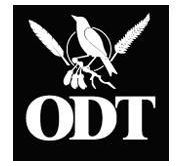(Credit: Deseret News, screenshot)
The Deseret News investigated summer intern Michael Smith’s writing after iMediaEthics alerted the Utah-based daily newspaper to attribution issues in one of his stories for the website. DeseretNews.com general manager Chris Higbee just told iMediaEthics that in all, it found 40 cases with “similar issues” in Smith’s writing.
Higbee wrote to iMediaEthics by e-mail:
“Thank you for your follow up yesterday and today. Upon confirming the errors in the original round-up story you informed us of, and rectifying them, we immediately began a review of all of the content produced by the intern in question. We discovered the additional round-up stories you found as well as 38 more that had similar issues.”
The investigation started yesterday, after an iMediaEthics inquiry. The Deseret News first rewrote a post by intern Michael Smith and added an editor’s note revealing that the story, which aggregated a report by The Washington Examiner, didn’t “meet our editorial standards.” The story was a mere 28 words shorter than the Examiner’s original report, and was either a mix of a light rewrite and verbatim copy-and-paste from the Examiner.
iMediaEthics dug a little deeper into Smith’s work for the Deseret News. We found two more stories where Smith either copied-and-pasted verbatim, lightly rewrote or poorly aggregated from original sources The New York Post and Canada’s CBC, after a quick look at some of Smith’s numerous posts for the newspaper’s website this summer.
After iMediaEthics reached out to the Deseret News again with these examples, the newspaper rewrote the posts in question and added editor’s notes disclosing that the original posts weren’t acceptable. We also heard back from DeseretNews.com’s Higbee with the news about the additional cases.
Higbee said that Smith’s work was vetted before publication but these cases somehow slipped through. He wrote:
“While an editor did review this intern’s stories prior to publication, and a copy edit was done, our analysis indicates a failure to clearly implement our own news aggregation and attribution policies during the editing process for these round-up stories. As a result, we didn’t catch and correct errors while teaching one of our interns industry standards. A further analysis of our training and controls is being conducted to correct such problems in the future.”
Further, Higbee noted that the Deseret News revealed these lapses to readers in a post on its own website. “We have posted a story on DeseretNews.com to inform our readers that, with your help, we have found all of the erroneous stories and they have been revised and notated, and that we have implemented training and tighter controls to correct such problems in the future,” Higbee e-mailed.
He added: “Thank you for your help in this, and thank you for your dedication to journalistic standards.”
In the story on the Deseret News website, Higbee commented further on the newspaper’s investigation of Smith’s work (the Deseret News didn’t name him in its online story about this case):
“Our analysis indicates a failure to clearly implement our own news aggregation and attribution policies during the editing process. All of the intern’s round-up stories were reviewed by editors prior to posting, however, editors did not provide appropriate review for attribution. As a result, we did not catch and correct errors while teaching one of our interns industry standards. The Deseret News apologizes to those involved, including its readers. We have implemented training and tighter controls to correct such problems in the future.”
To see what the problems were with Smith’s stories, read below for iMediaEthics’ analysis of two cases we flagged to the Deseret News last night.
Two Examples of Attribution Problems in Smith’s Stories
Curiously, in both cases, the byline for the story reads “Recommended by Michael Smith.” Yet enough changes have been made to each story to indicate the Deseret News was at least trying to give the appearance that the story was its own as opposed to re-publishing an excerpt from other sources. Plus, each story cites the original sources The New York Post and Canada’s CBC by using phrasing like “told CBC” and “The New York Post reported.”
Higbee also explained why Smith’s bylines had different information – some were labeled “recommended by Michael Smith” some said “by Michael Smith” and some said “compiled by Michael Smith.” According to Higbee, “The purpose for these delineations is to clarify for our readers those stories where the journalist did original reporting (using the ‘by’ byline credit), rounded up a number of stories from the internet on a news topic of interest (using the ‘compiled by’ byline credit) or recommended a single story from another website (using the ‘recommended by’ byline credit).”
CBC’s Hot Dog Story
Smith’s July 11 story for the Deseret News aggregated the CBC’s story from the day before, “Wal-mart employee fired after reporting dog in hot truck.”
Check out a side-by-side comparison:
- CBC: “A former employee of Wal-mart in Kemptville, Ont., says she was fired for confronting a customer who left a dog in a truck on a hot day this week.”
- Deseret News: “A former Wal-Mart employee says she was fired after callling 911 to report that a customer left a dog in a hot truck.”
And another example, with verbatim content bolded and light re-writes underlined.
- CBC: “The dog jumped out of the open window twice to follow the man, Cheney said. The man took his dog back to the truck and rolled up the windows, leaving them open about an inch, Cheney said. The man then headed into the Walmart.”
- Deseret News: “Cheney told CBC that she saw a customer leaving his dog in his truck before walking towards the entrance. The dog jumped out of the window twice (which was originally open) to follow the man inside. The man then put the dog back in the truck and rolled up the window, leaving about an inch open. He then went inside.”
A third example of a mix of word-for-word copying and pasting and light rewriting.
- CBC: “Later on that day, Cheney was called into the office of her manager, whom she had spoken to a week earlier about a different dog left in a hot car and who told her there was nothing she could do about it. She said she told him her side of the story about the dog in the truck and that he told her to come to him with any problems in the future.”
- Deseret News: “CBC reports that later in the day, Cheney was called in to her manager’s office, whom she had already spoken with earlier in the week about a different dog being left inside a vehicle. (She was told there was nothing she could do about it.) The manager allegedly told Cheney to come to him with similar problems in the future, but Cheney refused.”
And finally, a fourth example:
- CBC: “Cheney also said that another former Wal-mart employee was scolded last week for confronting a customer about leaving a dog inside a vehicle. She said that person had already given his two weeks’ notice, but that the manager sent him home and told him he’d be paid for the rest of the two weeks.”
- Deseret News: “Cheney said another former employee was scolded earlier in the week for talking to a customer who left a dog in their car. That employee, who had already put in two weeks notice, was told to leave immediately.”
After iMediaEthics’ inquiry, the Deseret News rewrote the post and added this editor’s note:
“Editor’s Note: The original version of this story posted on July 11, 2013, failed to properly attribute all source materials, which violates our editorial policies. The story was revised on Oct. 8, 2013, to attribute original source material.”
New York Post‘s Schindler’s List
Smith’s July 19 story for The Deseret News aggregated The New York Post’s story the same day about the eBay sale of a copy of the real version of Oskar Schindler’s list, the inspiration for the 1982 novel by Thomas Keneally and the 1993 movie based on the novel.
The Deseret News story is 314 words long. The New York Post story that it aggregates is 517 words long.
First, a comparison of the ledes for both story, where the Deseret News’ Smith copied the structure of the Post’s lede. This is the same thing that got Toronto Star intern Marc Ellison in trouble this past month.
- New York Post: ““Schindler’s List” is being auctioned off on eBay. No, not a DVD of the Oscar-winning Steven Spielberg film, but one of the original Schindler’s lists — the only one ever to go on the open market — will be publicly auctioned on the popular Web site.”
- Deseret News: “Schindler’s List, the document created by German Oskar Schindler to save the lives of over 1,000 Jews during World War II, can now be purchased on eBay. No, not the movie directed by Steven Spielberg, but an actual copy of the names of the Jewish refugees that Schindler employed as industrial workers to prevent them from being taken by Nazis.”
Another example where there is both plagiarism and a poor rewrite of the Post’s story.
- New York Post: “Of the seven original versions of the list, only four are known to still exist — including two in Yad Vashem, the Israeli Holocaust Memorial Museum, and one in the US Holocaust Museum in Washington.”
- Deseret News: “There were seven versions of the original list, but only four are believed to still be around. Two copies are located at the Yad Vashem, Israel’s memorial to Jewish victims of the Holocaust, and one at the United States Holocaust Memorial Museum in Washington, D.C.”
The Deseret News also inserted an error in the story by mis-identifying one of the sellers. See bolding below.
- New York Post: “But its sellers, California collectors Gary Zimet and Eric Gazin, are hoping it will go for as high as $5 million.”
- Deseret News: “The New York Post reported the story, and the Post‘s Emily Smith writes that the list is being auctioned for $3,000,000 by California collectors who own the only copy of the list that ever hit the free market. The owners, Gary Zimin and Eric Gazin, hope it can sell for as much as $5 million.
CBS News confirmed that the seller’s name was Gary Zimet, not Gary Zimin.
After iMediaEthics’ inquiry, the Deseret News rewrote the story and added an editor’s note to its story that reads:
“Editor’s Note: The original version of this story posted on July 19, 2013, failed to properly attribute all source materials, which violates our editorial policies. The story was revised on Oct. 8, 2013, to attribute original source material.”
UPDATE: 10/8/2013 5:23 PM EST: Added information about Higbee’s post on the Deseret News website.
CLARIFICATION: 10/8/2013 7:17 PM EST: Higbee finalized the count for iMediaEthics. There were a total of 40 stories with problematic attribution that have since been rewritten and corrected.
UPDATE: 10/9/2013 8:17 AM EST : iMediaEthics heard back from the intern in question. See our follow-up report with intern Michael Smith’s explanation for what went wrong.





